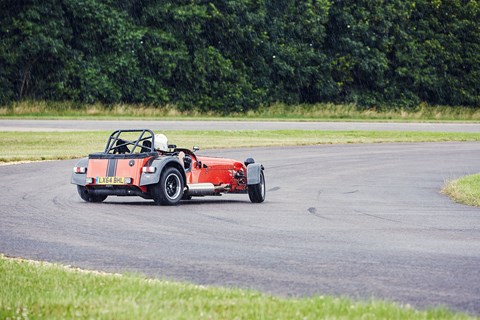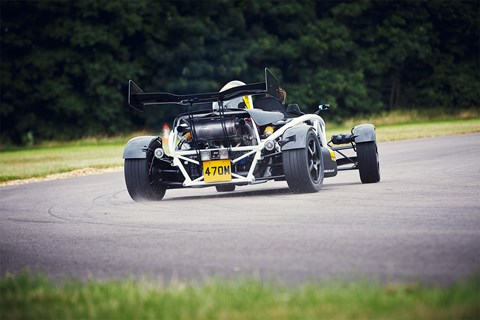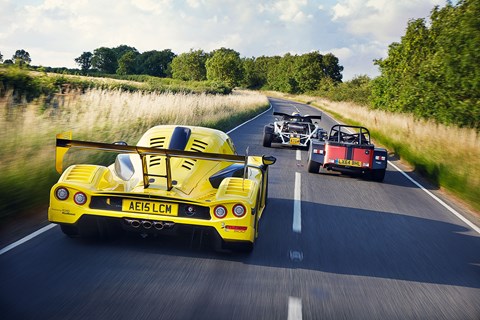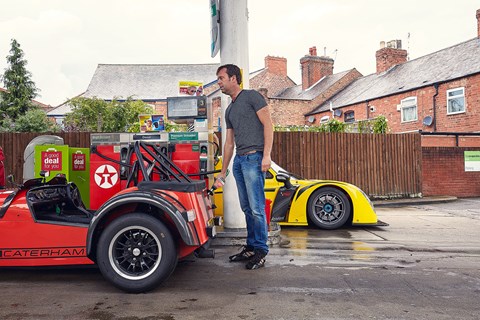► Caterham 620R #13
► Radical RXC Turbo #14
► Ariel Atom 3.5R #15
Britain leads the world in the creation of circuit-ready machines of unfeasible performance. And right at the top of the silly tree you’ll find these three…
There was a moment when it seemed sensible to stop. It was raining hard and the Ariel Atom had let out a yelp of supercharger whine, a mechanical ‘boo!’ that pre-empted loss of traction mid-corner. As the rear tyres spun, so the inside front tyre cut through a vast puddle, showering everything from my crash helmet to my shoes in gritty black water; it was like someone had sloshed a bucket over the cockpit.
But a car that weighs 520kg, makes 350bhp and fires off an easy sub-three 0-60mph twists your risk aversion. Adrenaline? Acclimatisation? Knowledge that I was doing this quite badly and might improve if I persevered? Who knows, but I just wanted to keep lapping. The rain got harder, the handling more lurid, my clothes wetter, and that supercharger kept on screaming. When the fuel ran low, I swapped into the Radical, then the Caterham. And then we drove them all home. You did spot the numberplates, right?
Cars like these reconnect driver and machine
Cars are getting safer, technology compensating for a general lack of attention and skill, and that means people like us need outlets like this – cars that allow us to reconnect with the performance car in its purest form.
Britain doesn’t claim to own the mentalist road-legal track-car genre, but it does do it best: Caterham, Ariel, Radical, BAC, Zenos, Ginetta, Lotus – the rest of the world can’t compete with a list like that. ‘Britain has a history of building specials and exotic vehicles dating to the birth of the car,’ explains Simon Saunders, boss of Ariel. ‘So from a design and manufacturing standpoint there’s an established industry that’s grown up supplying low-volume manufacturers. This, coupled with the racing car industry and OE manufacturers located here, gives us the knowledge and infrastructure. And then there are the British qualities of optimism, foolhardiness and sheer bloody-mindedness – they go a long way.’
To celebrate that spirit, we’ve assembled – not literally, God no – three of the most powerful Brit-built, road-legal lunatics on sale: Saunders’ Atom 3.5R, the Caterham 620R and Radical’s RXC Turbo.
Caterham 620R: what’s it like?
The Caterham Seven is the seminal track toy – around 21,000 have been built since 1973 – and the 620R is the most powerful in the marque’s history. Like the rest of the range, it clothes a mild steel spaceframe in aluminium, and combines double-wishbone front suspension with a de-Dion rear. Unlike the rest of the range, it straps a supercharger to the Ford Duratec four and bolts a sequential transmission to the back of the block. 310bhp might be only hot-hatch punchy, but the Seven weighs less than half those cars. Hence 569bhp-per-tonne and 0-60mph in a claimed 2.79sec.
 You step gingerly over the four-into-one exhaust, slinking down into that oh-so-cool sliver of carbonfibre seat, legs out in front like you’re about to Eskimo Roll. Climbing into a Caterham can be a faff, but that’s neatly sidestepped by this car’s optional carbon aeroscreen, which replaces non-essentials such as doors, roof and windscreen with a flick of black weave; you will get wet, you might get soaked as those log-flume signs warn, but you will also become seriously excited.
You step gingerly over the four-into-one exhaust, slinking down into that oh-so-cool sliver of carbonfibre seat, legs out in front like you’re about to Eskimo Roll. Climbing into a Caterham can be a faff, but that’s neatly sidestepped by this car’s optional carbon aeroscreen, which replaces non-essentials such as doors, roof and windscreen with a flick of black weave; you will get wet, you might get soaked as those log-flume signs warn, but you will also become seriously excited.
The engine pulses rowdily as raindrops explode off the hot exhaust’s fat silencer like insects on a trap lamp. Press the clutch, pull back on the stubby little gear lever and the sequential gearbox thunks into first gear with a racer’s mechanical engagement.
The 13-inch Avon ZZR tyres are essentially slicks with a few ‘Do we have to?’ grooves. Accelerate hard and they dig into the coarse surface, rocketing the Caterham forward. The 620R is quick, really quick, but its power delivery is progressive, and you have time to process what’s happening as the needle winds round the tiny analogue dial to 7700rpm, even if you have got David-Gest face.
Give the gearlever a hefty pull for second gear. It connects hard and you just keep your right foot pinned through the change; it adds the smallest hiccup to the violent onslaught, which feels like it’s on a constant Gif-like loop.
You steer a Caterham with arms outstretched, wrists just a few inches apart. Your palms sense the loads telegraphing through the front end as forces build in corners, letting you know you’re reaching the limits. It’s an incredibly tactile experience. The Caterham is not a car that particularly encourages huge powerslides, instead it prefers the subtler angles you generate when pushing hard and need to wind on a quarter turn of lock. Driving it like that, just beyond its limits, catching little slides and wap-wap-waaaaping the throttle to ride them out is at the core of this experience. Soon you learn to trust in its benign balance, that you shouldn’t be scared of asking absolutely everything from the rear tyres because this is a car that’s happiest when steered from the rear. Understeer? Never felt any. Great brakes too: reassuring early bite, progressive pedal travel and massive stopping power with excellent stability.
Ariel Atom 3.5R and the whailing supercharger
The Atom is an even more intense experience. It is not Ariel’s most powerful product – that honour lies with the 500bhp Atom V8 – but the 3.5R is faster around a typically twisty circuit, and 350bhp with 673bhp-per-tonne is sufficient. Just don’t forget the full-face helmet, lest people see you laughing spasmodically and shouting at a car like it’s just cheekily pinched your arse.
Ariel claims the 0-60mph dash in ‘approaching’ 2.5 seconds. Last year I managed a 2.89sec and my head almost fell off. The rush of acceleration can be so overwhelming that the shift lights crowning the digital dash are essentials, not fripperies. I swear you don’t breathe under full-bore low-gear thrust, then there’s the blast of air from the pneumatically activated gearchange, and that insane wail of supercharger; at first it’s like stumbling disoriented through the haunted house at the funfair. And then it just keeps on pulling, any gear, any speed.
 Clearly, there are some key differences compared with the Caterham. You sit in moulded composite seats inside a steel exoskeleton, and every bit of engineering is showcased like an automotive Centre Pompidou: the Tilton pedalbox, the braided brake hoses, adjustable Ohlins inboard dampers just a peek away over the tiny fly-splattered screen. The Atom is a massive 315mm wider than the Caterham and the supercharged Honda engine hangs over the rear wheels, not behind the fronts.
Clearly, there are some key differences compared with the Caterham. You sit in moulded composite seats inside a steel exoskeleton, and every bit of engineering is showcased like an automotive Centre Pompidou: the Tilton pedalbox, the braided brake hoses, adjustable Ohlins inboard dampers just a peek away over the tiny fly-splattered screen. The Atom is a massive 315mm wider than the Caterham and the supercharged Honda engine hangs over the rear wheels, not behind the fronts.
It feels even more composed than the Caterham through corners, and it’s got some proper aero going on, which is perhaps why there’s a more relaxed feel to its front end when you really lean on it. Yet the 3.5R is also the most playful car here. Get the front tyres loaded into a corner and squeeze the throttle and it’ll adopt more angles than an infertile set-square, all the weight over the rear end both helping you play and adding controllability.
Steering lock runs out pretty quickly if you overcook it, though, and the revs spike so quickly that you can ping the limiter like a strongman ringing the bell on a test-your-strength totem pole; which makes it all the more alarming when you learn that the limiter resides beyond 8400rpm, so quickly does it arrive. But like the Caterham, this is a car whose initial intimidation disperses with familiarity, and you realise that not only are the Kumho Ecstas and the engine location a match for the power, but that you don’t need to pussyfoot about. You can experiment and overstep the limits. In fact, like the Caterham, there’s a real sense of fun to the Atom. It understands communication and involvement, and that cheeky powerslides are worth more than a few tenths of laptime.
Sometimes, though, things do move so quickly in the Atom that it becomes difficult to judge your braking, excellent though the four-pots are. I repeatedly slowed prematurely for a corner, before leaving it just a little later and braking far too deep. Do that and things get very tricky: all the weight tips over the front, the rear goes light and the engine does its best to pirouette the car. It’s a very fine line that takes practice to nail. (I need more practice).
Radical RXC Turbo: the expensive toy
The Radical represents a very different philosophy. You might know the firm from its one-make races, but while it has road-legalised its racers before – the SR8 LM still holds the Nürburgring production-car lap record – the RXC is its first stab at a proper road car.
The RXC is based around a laser-cut tubular steel spaceframe, its bodywork inspired by Peugeot’s 908 Le Mans racers. It has double wishbones and pushrod dampers all round, a seven-speed sequential gearbox and some serious aero too. Inside, you get leather with contrasting stitching, electric mirrors and air-con. I appreciate some of those features, but I think Caterham and Ariel are wiser to make a virtue of less complex ‘interiors’.
 Two RXCs are available: the 3.7-litre RXC with up to 380bhp, and our Turbo. It costs £119,500 and makes 530bhp and 481lb ft, but in this company 1148kg puts it bottom in the power-to-weight stakes with 461bhp-per-tonne.
Two RXCs are available: the 3.7-litre RXC with up to 380bhp, and our Turbo. It costs £119,500 and makes 530bhp and 481lb ft, but in this company 1148kg puts it bottom in the power-to-weight stakes with 461bhp-per-tonne.
Its capability comes not from being ludicrously powerful or brain-bendingly light, but from its nuanced set-up: chassis, brakes, power delivery, traction, aero, all combine to make this an incredibly effective tool.
At first, I find it a little flat compared with the exuberance of the other two. The throttle is soggy, the engine lacks charisma, the gearchanges are quite soft, and it just feels psychopathically detached considering what’s playing through the windscreen. Instead, the fun’s had from being measured and neat, from carrying vast speed through corners, trusting the aero, extracting the fastest lap you’re capable of. You’re never in any doubt that this is a pseudo road car from people who make racing cars
Even in the wet the RXC’s composure is startling. You can turn it into bends faster than you’d believe possible, then get on the throttle early and trust entirely that the GT3-spec rear wing will help the Dunlop Direzzas find traction.
Part of the magic comes from the downforce, but it’s the dampers too. Remember Schumacher’s world championships with Benetton, when rivals suspected he was running traction control? It was actually highly compliant Intrax dampers that quelled wheelspin. And Intrax developed the RXC’s dampers. Bounce the kerbs and you’ll feel that unperturbed composure, a feeling that you can just pick your line, smash through any bumps and everything will hook up.
The electric steering – cockpit adjustable assistance from 0-5 – is quick and laser accurate and, set to 5, inspires hope of winding on lock if you get it all wrong at big speeds. The brakes give you immense confidence to push, too. They stop you like you’re chained to a truck – again, even in the wet – and initially made me feel nauseous. They are, by a margin, the most effective stoppers here.

Verdict
Later that evening, we take these cars out on the road and we might as well be driving a convoy of moon buggies. I’m driving the Caterham, sticky tyres losing temperature and feeling pretty unsure of themselves; Matt Tarrant’s up front in a climbing frame with spoilers; in my vibrating mirrors I can see James Taylor chasing along in a car that looks like it won Le Mans a few years back. Everyone stares in absolute bewilderment, because in a world of mandatory airbags and stability control and ABS, nut-jobs like this shouldn’t really exist. But you know what? We should all be glad they do.
Speed merchants
Ariel
The first Ariel was a penny-farthing with a 48-inch front wheel in 1870. Cars followed but in 1916 production switched entirely to motorbikes until the 1970s. In 1999 Simon Saunders dusted off the dormant name for the Atom. Today, Ariel is based in Crewkerne, Somerset and employs 25 people. Output is around 100 cars per year and Ariel has made two recent additions to the range: the Atom-based Nomad buggy, and the Ace motorbike.
Radical
Radical is based in Peterborough, and was founded in 1997 by Mike Hyde and Phil Abbott. The first Radical was the Clubsport, a lightweight racer with a motorbike engine. The SR3 launched in 2002, and remains Radical’s most popular car with an estimated 900 produced in total. Radical has sold 65 RXCs since 2014, but manufactures around 180 cars annually and is best known for its race series: the SR1 Cup, Sprint Championship, Enduro Championship and European Masters.
Caterham
When Lotus stopped producing the Seven, Lotus dealer Caterham Cars snapped up the rights in 1973. Today, the firm has its headquarters in Crawley, Surrey, and employs around 110 people in the UK, with a growing international sales network. Approximately 500 Caterhams are produced annually, with 70% going overseas. The range has recently been realigned into Seven 160, 270, 360, 420, 620R and CSR. All Caterhams except the CSR and 620R are available to build in kit form.

Mad Car Disease: the track toy specs
Radical RXC Turbo
Price: £119,500
Engine: 3496cc 24v twin-turbo V6, 530bhp @ 6100rpm, 481lb ft @ 5000rpm
Transmission: Seven-speed sequential, rear-wheel drive
Suspension: Double wishbones and inboard dampers all round
Performance: 2.8sec 0-60mph, 185mph, 19.1mpg, 343g/km CO2
Length/width/height: 4300/1960/1127mm
Weight/made from: 1148kg, steel spaceframe/composite body
Rating: ****
Ariel Atom 3.5R
Price: £64,800
Engine: 1998cc 16v supercharged 4-cyl, 350bhp @ 8400rpm, 244lb ft @ 6100rpm
Transmission: Six-speed sequential, rear-wheel drive
Suspension: Double-wishbones with inboard pushrod dampers
Performance: 2.5sec 0-62mph, 155mph, 32mpg, 215g/km CO2
Length/width/height: 3410/1890/1195mm
Weight/made from: 520kg, bronze-welded steel tubular chassis
Rating: *****
Caterham 620R
Price: £49,995
Engine: 1999cc 16v supercharged 4-cyl, 310bhp @ 7700rpm, 219lb ft @ 7350rpm
Transmission: Six-speed sequential, rear-wheel drive
Suspension: Double-wishbones, de-Dion rear
Performance: 2.79sec 0-60mph, 155mph, 30mpg (est), 220g/km CO2 (est)
Length/width/height: 3100/1575/1115mm
Weight/made from: 545kg, mild steel spaceframe
Rating: ****